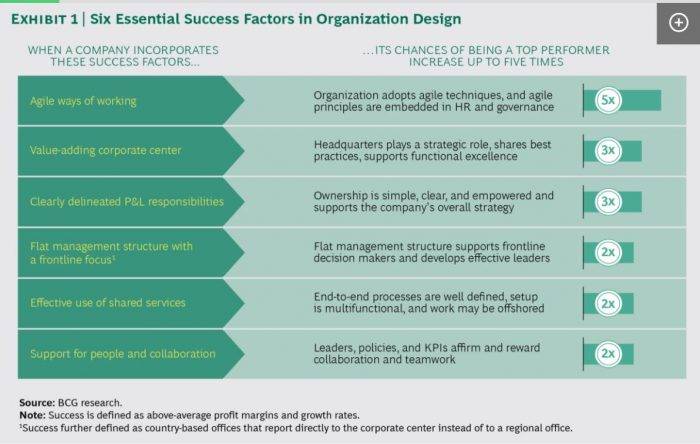July 17, 2017
Top performing organisations build six elements into their design
 Adopting agile ways of working makes a company five times more likely than competitors to be a top performer, with faster growth and higher profits, according to a new report from The Boston Consulting Group (BCG), “Boosting Performance Through Organization Design”. The report describes agile as ‘a concept borrowed from software development, describes workplace processes that emphasise speed, autonomy, and teamwork to get products to market faster’. It is one of six key factors of organisation design that set top performers apart from rivals, according to results of a BCG survey included in the report.
Adopting agile ways of working makes a company five times more likely than competitors to be a top performer, with faster growth and higher profits, according to a new report from The Boston Consulting Group (BCG), “Boosting Performance Through Organization Design”. The report describes agile as ‘a concept borrowed from software development, describes workplace processes that emphasise speed, autonomy, and teamwork to get products to market faster’. It is one of six key factors of organisation design that set top performers apart from rivals, according to results of a BCG survey included in the report.
Truly agile companies build the practice into everything they do, said Fabrice Roghé, a Düsseldorf–based senior partner at BCG and coleader of the firm’s People & Organization practice. “They make it a point to create agile leadership models where managers become coaches, and give teams leeway to figure out how to reach set targets.”
The other key factors include:
- A value-adding corporate centre
- Clearly delineated profit and loss (P&L) responsibilities
- A flat management structure with a strong frontline focus
- Effective use of shared services
- Strong support for people and collaboration
 Whether operations are segmented by product line, region, P&L or some other criterion, when companies incorporate all six of these factors into their organisation design the likelihood of being a top performer increases to more than 50%, according to the article.
Whether operations are segmented by product line, region, P&L or some other criterion, when companies incorporate all six of these factors into their organisation design the likelihood of being a top performer increases to more than 50%, according to the article.
By contrast, companies that include a single one of the factors into their organisation design have only a 20% chance of becoming a top performer and a 44% chance of underachieving.
Though corporate centres are often painted as a burden, effective headquarters functions make a company three times likelier to have fast growth and higher earnings than their peers, second only to agile ways of working in return on value. At top performers, in addition to managing funding and strategic planning, corporate centres set and monitor best practices, find opportunities for business units to work together, and make sure performance reviews line up with company goals, according to the article.
“Getting key factors such as agility, a value-adding corporate centre, flat management structure, and effective shared services right can help companies simplify decision making and foster cooperation,” said Andrew Toma, a London-based BCG senior partner and expert on organisation design.
Top performers also cultivate a people-focused culture, supporting staff by giving individuals specific responsibilities, both for their own jobs and for the work they do in teams, relying on simple decision making, rewarding collaboration, and scheduling meetings only when they are needed.
Results are based on an online survey BCG conducted in the fourth quarter of 2016 of approximately 1,100 executives and other employees at midsize and larger companies (of 1,000 employees or more) representing ten industries and more than 40 countries. Questions covered company size, operational design, and performance, among other things. Top performers were defined as growing faster and maintaining higher profit margins than competitors. Results were weighted to compare equal numbers of successful and unsuccessful companies and data normalised accordingly. Results are offered for guidance only. BCG collaborated on the survey with Gesellschaft für Organisation (Society for Organization),Österreichische Vereinigung für Organisation und Management (Austrian Association for Organization and Management), Schweizerische Gesellschaft für Organisation und Management (Swiss Society for Organization and Management), and the Japan Management Association.













